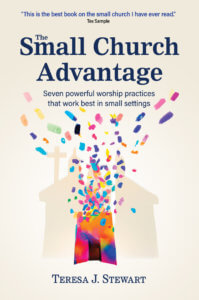Teresa Stewart says that small congregations have a powerful worship planning option that expands participation, emphasizes lay leadership, ends the burnout of meetings, invites local gifts, and heightens anticipation. It’s called Stone Soup worship planning.
Maybe you’ve heard it said that for lavish worship, congregations must have a “Worship Design Team” — experts gathered to design, script, rehearse, and coordinate the event. In detail. Every. Single. Week. But what if small congregations have a more powerful option — one that expands participation, emphasizes lay leadership, ends the burnout of meetings, invites local gifts, and heightens anticipation? They do. It’s called Stone Soup worship planning.
An invitation to imagine and help
Stone Soup is a popular European folktale. It’s told in different ways around the world, but the essence is this: A stranger shows up in a small village. The stranger is hungry. So are the villagers, but there seems to be nothing to eat. Everyone has so little. All are starving and wary. So, the stranger starts the hospitality by setting out a giant pot and politely asking for a large stone. He claims to have a delicious soup recipe. As the villagers gather to watch, he builds a fire, fills the pot with water, and drops in the stone. He stirs it with delight and anticipation. After tasting it, the stranger announces that it’s good but would be much better if only there were a little carrot to add. Eventually, a villager produces a hidden stash of a few carrots. The stranger savors a taste and announces that it would be even more delicious with a little onion or some meat. A villager returns with the ingredients.
Over and over again, the traveler declares the soup good and wagers that it could be even better if …. Over and over again, the villagers bring out what seem like meager offerings on their own. Together, however, they create an enormous, nourishing soup that feeds them all. Starting with just a stone. The recipe for delicious soup isn’t a list of ingredients. It’s an invitation to imagine and help.
The Stone Soup worship planning model
That’s the goal of this style of worship planning. Invite, imagine, help. With this model, the pastor is the stranger. And the pastor doesn’t arrive with an apron, a cooler of ingredients, and the recipe for beef wellington. Instead, the pastor arrives with a simple guide and the ability to stir, encourage, add, and declare good all those gifts hidden away by hungry folks. Somehow through the process, the fear of scarcity transforms into a feast of abundance.
This collaborative work starts with the pastor. Well in advance, the pastor thoughtfully and prayerfully lays out the month or liturgical season. A month at a time, the pastor makes a one-page guide with the following information for each week:
- The scripture
- A short thematic statement
- A related image, sign, symbol, or question
After the pastor creates the simple guide, the work shifts to recruiting, encouraging, and handing off tasks. Then the pastor recruits lay leaders — just for that month — for specific tasks. Like decorating the altar/chancel/sanctuary, offering children’s worship, reading scripture, or creating a short drama. The pastor hands off the guide to each of the lay leaders and encourages their interpretations and gifts: Share whatever you have. No meetings or rehearsals. Just anticipation about what might be made together on Sunday.
The goal is to give gentle direction and generous permission. To show that their gifts truly matter. And more people will take risks in sharing their gifts in worship a month at a time. For the first year, recruit laity for specific jobs one month at a time. Period. Pastors may want to start the recruiting work, but laity can also notice, encourage, and invite.
Too overwhelming? Pick one for starters. Try a once-a-month approach for the dramas and visual arts, but don’t be surprised if a hunger grows for more jobs. Then turn to include gifts from your community. Can the local photography buff take pictures of where she sees God in your community? Can the flute player at the high school offer a song of celebration? Can a home baker prepare a sourdough starter and a plan for delivering bread?
How the Stone Soup method worked in one church
Here’s what one pastor did. She didn’t rally the burnouts to push harder. Or assure them that she could fix it. And she didn’t focus on weekly worship scripts that would increase the performance value. Instead, she spent her time learning all the gifts, interests, and talents in her congregation and community. Especially the hidden ones that didn’t usually show up on Sunday mornings — things like photography, painting, baking, and flute playing.
She wrote a simple, one-page Worship Guide for the month. Then she set out recruiting and encouraging: I noticed that you …. Here’s a guide …. I wonder if you could help us in worship.… And nervously, the pastor said yes to every gift, interest, and talent offered. She handed out tasks — even on Sunday mornings: Could you fill the baptismal font and invite people to remember this gift? She involved visitors: Would your child like to carry in the light of Christ? And recruited others even when she could do the task better or more efficiently.
Each week was a surprise, a thoughtful interpretation of the worship guide. Bales of hay from the field outside were stacked as an altar and decorated lavishly for a Thanksgiving celebration. The narthex became a welcoming living room. Some youth in the community began writing a drama each month. A farmer who attended the church years ago showed up with animals on Christmas Eve. There was a buzz in the community grocery store each Monday: I wonder what they’ll be doing this week. Two years later, worship participation is denser. More people do more worship work. The path between the church and community is better worn. Even in a struggling, shrinking rural community, there’s a sense of abundance.
 Adapted from The Small Church Advantage: Seven Powerful Worship Practices that Work Best in Small Settings (Market Square Books, 2023) by Teresa J. Stewart. Used by permission. The book is available at Market Square Books, Cokesbury, and Amazon.
Adapted from The Small Church Advantage: Seven Powerful Worship Practices that Work Best in Small Settings (Market Square Books, 2023) by Teresa J. Stewart. Used by permission. The book is available at Market Square Books, Cokesbury, and Amazon.
Related Resources
- Creating Powerful Worship in Small Congregations featuring Teresa Stewart — Leading Ideas Talks podcast episode | Podcast video | In-depth interview
- Revitalizing Worship is More than a Question of Style by Donna Claycomb Sokol and L. Roger Owens
- Small Church Big Impact by Blake Bradford







